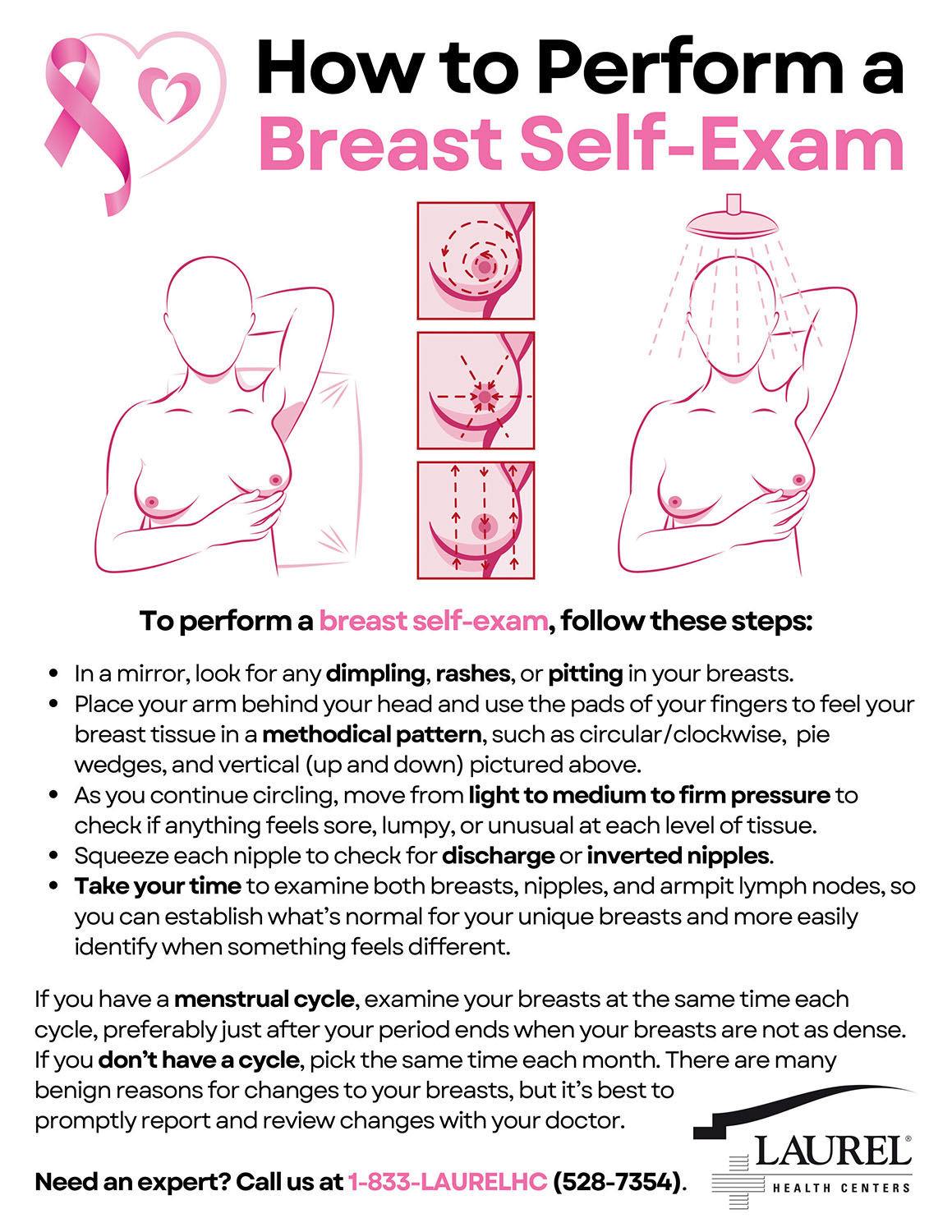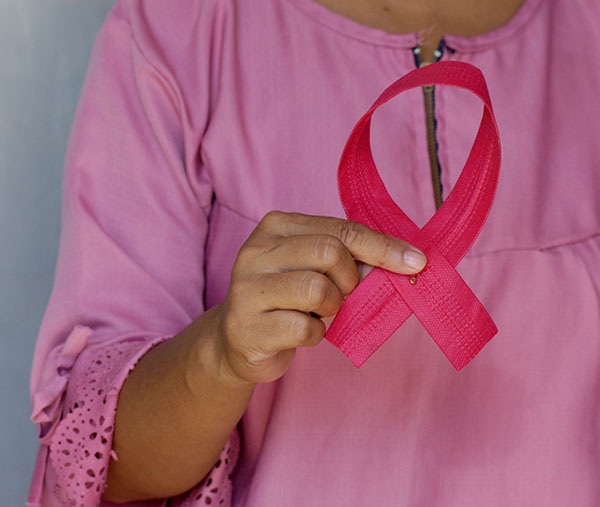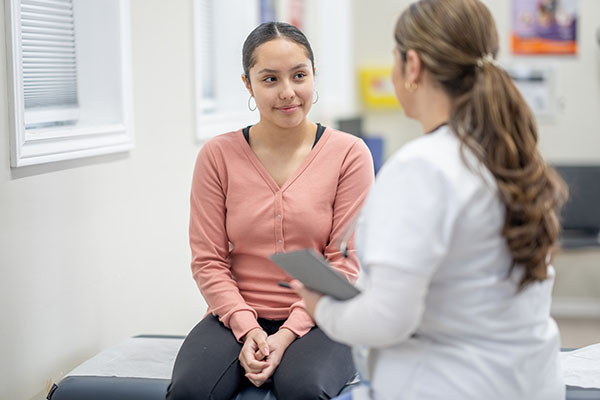A Monthly Breast Self-Exam Could Save Your Life
By Kristy Warren
No two women are the same and neither are their breasts. A breast self-exam helps you learn your breasts’ unique characteristics—and knowing what’s normal for you helps you spot potential problems early and promptly discuss any changes or concerns with your doctor.
If you still have a menstrual cycle (period), examine your breasts at the same time each cycle, preferably a few days after your period ends when your breasts are not as dense, lumpy, or tender. If you don’t have a cycle, pick the same time each month. Through routine exams, you’ll learn what is normal for you.
Below our Laurel Health experts share how to perform an effective monthly exam, including what to look for and tips on technique.

HOW TO COMPLETE A BREAST SELF-EXAM:
- Either standing or lying down, place your one arm behind your head.
- Using your opposite hand, gently move your fingertips around your breast in small, circular motions in a clockwise or pie-wedge pattern. Next try a vertical pattern (up and down). Make sure to feel your entire breast area, including above / below your breast and into your armpit to check for swollen lymph nodes. See the diagram above as a visual aid.
- As you continue circling, move from light to medium to firm pressure. Does anything feel sore, lumpy, or unusual at any level of pressure?
- In a mirror, look for any dimpling, rashes, or pitting in your breasts. Does anything look different?
- Squeeze your nipple and check for discharge or blood. Check whether your nipples are inverted (collapsed in instead of flat or protruding)?
- Repeat these steps for your other breast and armpit.

If you aren’t sure you are doing the self-exam correctly, ask your healthcare provider to perform a breast exam on you. You can learn the proper technique firsthand and feel confident performing the exam on your own.
It's a good idea to have your doctor perform a breast exam at your yearly physical as part of your wellness screenings.
WHEN SHOULD I START SELF-EXAMS AND MAMMOGRAMS?
We recommend you begin monthly breast self-exams in your twenties, but it’s never too late to start! Routinely examining your breasts will help you learn what is normal for you. Knowing what’s normal for your breasts and checking that each month helps you and your provider stay on top of any changes much sooner than solely relying on an annual mammogram.
Mammograms compress and x-ray the breasts to detect any potential cancerous tissue. They can also identify benign masses like cysts and fibroadenomas. When you should receive your first mammogram depends on your personal level of risk and family history.
Most women of average breast cancer risk should receive their first mammogram between the ages 40 and 45. Your healthcare provider will advise if you should receive mammograms annually or once every two years based on your health and history. 3D mammography may be recommended if you have dense breast tissue.
Those who have a significant family history of breast cancer, genetic mutations associated with breast cancer, or a previous breast health issue may be advised to be screened earlier and more often. For women under 40 with breast health concerns, other imaging tools like breast ultrasounds are more likely to be used.
Make sure to talk to your family doctor if you have any questions or concerns about completing your breast self-exam or mammogram. We’re here to help!
WHEN TO SEE A DOCTOR
It’s normal for your breasts change slightly during your cycle and as you age, but if you experience any of the following changes, make an appointment with your family doctor for further examination:
- Discharge from your nipple(s)
- Lump(s) or thickening breast tissue that does not shift during your menstrual cycle
- Changes in the shape, texture, or size of your breasts
- Changes in the appearance of the skin or nipples
- Discovering any portion of your breast that feels different than it did at this same time during your previous monthly self-exam
While these changes can be the result of benign cysts or non-cancerous tumors called fibroadenomas, it's best to have them checked out by a professional.
To determine the cause and type of lump, your doctor may order imaging like an ultrasound or mammogram and may request a biopsy.

HOW CAN I LEARN MY BREAST CANCER RISKS?
Many factors determine your overall risk of developing breast cancer, including your age, race, pregnancy, breastfeeding, activity levels, alcohol consumption, and genetics.
One of the most important ways to determine your personal risk is to discuss your family history and personal medical history with your doctor.
While breast cancer is more common in women, men can also be diagnosed with breast cancer and should take an active role in monitoring their breast tissue for changes. If possible, try to determine who has had breast cancer within the last two to three generations of your family tree and his or her age at the time of diagnosis.
PROMOTING GOOD BREAST HEALTH
In addition to regular breast self-exams, you can support your breast health by eating well, exercising, quitting tobacco, and maintaining a healthy weight. Eat a diet high in fiber, vegetables, and fruit, lower your fat and sugar intake, and aim for at least 20 minutes of exercise daily.
Remember, you are the best advocate for your health! By learning what’s normal for you and your breasts, understanding your personal risk for breast cancer, living a healthy lifestyle, and keeping up with your breast health screenings, you are giving yourself your best chance at good breast health.
If you are due for a breast exam, or would like to discuss your personal breast cancer risks, make an appointment with The Laurel Health Centers at 1-833-LAURELHC (1-833-528-7354).
Need a primary care provider? Click here to visit Laurel Health's provider directory to find a healthcare provider who will be a great fit for your care!
